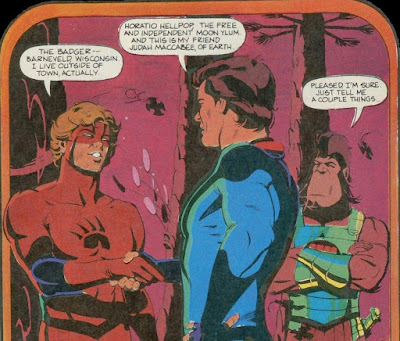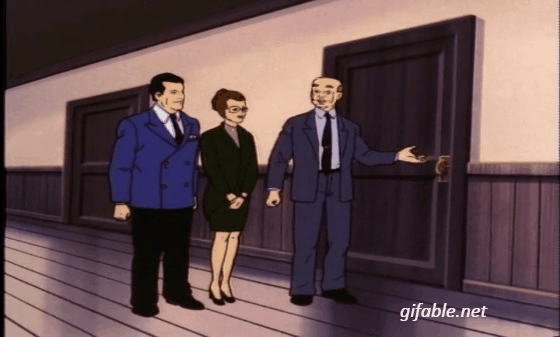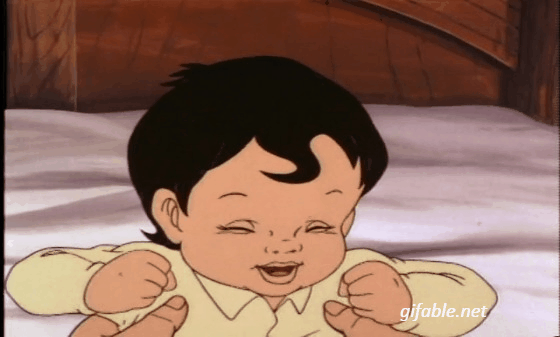Note: This review was directly influenced by a house ad Micheal Bailey posted in his very excellent Fortress of Baileytude website. If you're a Superman fan and are seeking a great example of a well-organized website that discusses Superman in great depth, I'd recommend checking out Bailey's site. These cards had been sitting on our desk for the last 4 months now, and we swore we'd do a write up on them sooner... but, better late than never. ;)
Following DC's
1992 Death of Superman event, and then the subsequent
Reign of the Supermen event, public interest in Superman was at an all-time high during
1993. [
Comichron.com lists that 1993's
Top 5 highest-selling comics were all
Superman comics.]
DC comics — recognizing a good thing when they saw it
— quickly released a flurry of licensed products to capitalize on the renewed interest in the comic book property, and collectors were soon treated to a
Superman: Man of Steel Platinum Series trading card set (published by
SkyBox) in
1994.
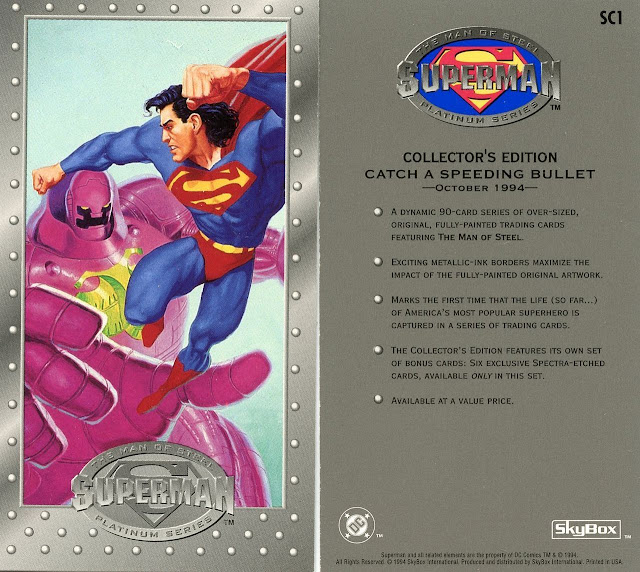 |
| Promo card for lower-budget 'Collector's Edition'. Painted by Daniel Horne. |
In the early 90s,
DC comics had always been
2 years behind Marvel comics when it came to producing trading card sets. Case in point: it was only 2 years AFTER
Marvel had released their
Marvel Universe I trading cards that
DC had released it's
first non-movie trading card set [
Doomsday: The Death of Superman,
SkyBox 1992]. By the time
DC had released it's 1992
DC Cosmic Cards trading card set (it's first
all-encompassing DCU trading card set),
Marvel was releasing it's first
fully-painted Marvel Masterpieces trading card set.
I'm sure this had to do with the fact that
Topps held the Batman license as far as trading cards were concerned. [I bet you noticed the absence of any Batman and Batman-related characters in any pre-1994
Impel/Skybox DC trading card sets, eh?] I don't know why
DC didn't just stick with
Topps for trading card publishing. Maybe
Impel/Skybox was offering them a better licensing deal? Either way, I'll probably come back and re-write these last few sentences someday when I have some hard evidence as to why
DC didn't want to do business with
Topps anymore.
Thankfully, this all turned around come
1994 when
DC released about half a dozen trading card sets within the span of a single year. When I sit down and calculate it, I'm pretty sure I spent more of my disposable income on trading cards
about comic books that year than I did on
actual comic books.
Don't get me wrong
— as a
DC comics fan, 1994 was a
great year for non-sports trading cards: we got our first REAL Batman trading card set, our first
fully-painted DC comics set, and the introduction of
over-sized/widevision trading cards. I think a lot of us
DC fans exhaled a collective sigh of 'finally' as
DC had finally caught up to
Marvel in terms of variety of product and quality. Besides, I was getting tired of having my
Marvel friends flaunt their
Marvel Masterpieces cards and me wishing out loud that
DC would produce something just as good.
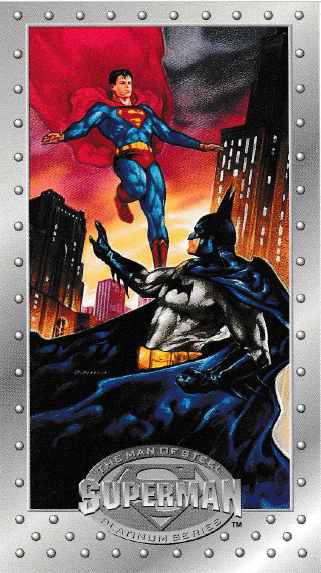 |
| #32: "Behold, A Dark Knight!" — painted by Dave Dorman |
The
Superman: Man of Steel Platinum Series trading card set had all the elements of an 'instant win'. A few details that immediately caught my attention included:
- it was a 90-card series of over-sized, fully-painted trading cards,
- it recounted Superman's life from Superman #1 (1987) up until then-current 1994,
- it was released at two price points: a collector's edition and a premium edition,
- and it was 'a limited collection, with production less than that of the celebrated "Doomsday: Death of Superman" trading card series'.
A
fully-painted trading card set was pretty exciting for fans. At this point, a fully-painted
anything was pretty exciting for fans.
Alex Ross and
Kurt Busiek's
Marvels [published by
Marvel Comics] was released earlier that year, and within weeks
Alex Ross became a household name [among comic book fans, anyways]. As previously mentioned,
Marvel had already released a set of trading cards with the realistic and highly-detailed painted art of
Joe Jusko two years prior, so this was
DC playing 'catch-up'. The
Superman: Man of Steel Platinum Series was
not DC's first fully-painted trading card series of the nineties, that distinction went to the
DC Master Series (which was released a few months prior).
The
over-sized/widevision aspect was a nice selling point
— but, at this point, I remember collectors still being kind of unsure about this new format. On the plus side, you were getting more card [a widevision card measured
2.5" x 4.5" vs the standard
2.5" x 3.5" trading card], but the unusual size of these trading cards meant that you either had to buy six-pocket plastic card protector sheets or you had to keep 'em stacked up in a pile somewhere safe. Since the six-card protector sheets were a
little more expensive and were only meant for widevision cards, a lot of us opted for the
pile 'em somewhere safe option. Upon further recollection, I seem to recall collectors dismissing this as a 'flash in the pan' as far as the gimmick era of trading cards were concerned, so they didn't think to invest much into it. Surprisingly, the 'widevision format'
did survive, and was heavily utilized by
Topps (of all companies) for it's
Star Wars trading card sets.
 |
| #64: "Panic in the Sky!" — painted by Bill Sienkiewicz |
To me, the biggest achievement of this card set was getting me interested in
Superman again. I'll be the first to admit, Superman is
NOT my favorite
DC character. Yes, I did follow the
Death of Superman and
Reign of the Supermen! storylines, but only because I thought he was getting phased out and being replaced with someone more contemporary. Other than that, I had little to no interest in Superman or his history. To me, he was too powerful and lacked the frailties that made for an interesting protagonist.
 |
| #65: 'To Lead the Justice League' — painted by Nick Choles |
This card set covered the first seven years of Superman's career since the
John Byrne's 1987 reboot (most of the events spotlighted are from the
Superman v2 ongoing series) and concluded somewhere shortly after Superman's return from the dead. I liked that not every card depicted 'the shot heard around the world' and sometimes revisited some of Superman's less-epic confrontations... like his first encounter with C-list villain Rampage (who later became a supporting character in
Starman v1) or when Superman battled Massacre [a villain so forgettable I had to look up his name twice]. Many cards feature characters you already recognize, which piques your interest even more and makes you realize Superman's post-
Crisis career may have been more entertaining than you originally gave it credit for. In short, it's really hard NOT to get interested in Superman after flipping through these cards.
 |
| #41: 'Rampage!' — painted by Hector Gomez |
The two different price points (
premium edition for the more
serious collector, and
collector's edition for the budget version) made this a very tempting impulse purchase for high school students who only had $10 to their name every week. My local hometown comic book shop sold the
collector's edition for approximately 3 weeks before they were gone from the shelves and I never saw them again. I wasn't even aware a
premium edition of this set existed until a few years ago.
The big difference between the two versions wasn't just the price, but the overall look & feel of the cards and the potential inserts/chase cards you could pull from a pack. While the
collector's edition had a nice enough (if not plain) metallic ink border, the
premium edition had a shiny reflective metal border with embossed rivets. The six
chase cards in the
collector's edition consisted of
Spectra-Etch versions of cards found in the base set (1:7), and while they may have looked good, weren't exactly 'must haves'. Meanwhile, the
premium edition contained the
Kerry Gammill-designed
SculptorCast insert cards (1:18) and the highly-coveted
Man of Steel SkyDisc (1:240).
 |
| Forged-In-Steel SculptorCast FS3: "Showdown with Doomsday" by Kerry Gammill |
The
SkyDiscs were the holy grail of DC trading card collectors in 1994. I personally don't own any, but I've seen them before at trading card dealer's tables. They look like honest-to-God holograms
— like you're peering down at a green 3D model of Superman through a little circular porthole (this was a big contrast to the early "holograms"
Impel/SkyBox was using for it's
DC Cosmic Cards and
DC Cosmic Teams insert sets, which seemed more like several layers of foil enhanced 2D images than an actual 3D hologram).
SkyDiscs were pretty big in 1994, as
SkyBox released 4 of them that year (usually as a cherry to top off a set). There was a Batman
SkyDisc available in the
Batman Saga of the Dark Knight trading card set, another Superman
SkyDisc available in the
DC Master Series trading card set, the aforementioned Superman
SkyDisc from this set, and a Death
SkyDisc in the widevision
Vertigo trading card set. The widevision
Sandman trading card set included a
3-D Stereo Hologram chase of Morpheus
— but I've never seen it in person so I can't confirm if it looks like a
SkyDisc or not. The
DC Master Series contained '
SkyDisc redemption' cards (which you needed to send away for in order to receive your
SkyDisc), and I'm not 100% sure if the
Man of Steel Platinum Series had a redemption card system, as well. Nevertheless, as a lover of all things holographic, I'm seriously going to need to track these down someday.
A snazzy binder was also available to collect the trading card set:
I didn't know this binder even existed until I started researching this card set. I'm guessing this was something you needed to order directly from
SkyBox? I have no clue if it came with the entire trading card set decked out in 6-pocket plastic card protector sheets, or if you were expected to buy the cards separately.
It's written right on the promo card [see
Bailey's link] that this collection was '
limited' and had a '
production less than that of the celebrated "Doomsday: Death of Superman" trading card series'. So... how many
Doomsday: Death of Superman trading cards were produced? Apparently,
only 10,000 cases of the
SkyBox Doomsday: Death of Superman trading cards were produced in 1993. That doesn't really feel that scarce
— especially since I often stumble on dealers trying to sell the entire base set for $5 USD.
 |
| #49: 'Mongul!' — painted by Scott Hampton |
I always have to laugh when the set boasts that '
Roger Stern wrote the text copy' as a selling point. I guess this was to add to consumer confidence?
Stern was heavily involved in the
Superman-titles from the late-80s to the mid-90s. I'm chuckling because I don't think anybody really cares who wrote the text copy, as long as it has some sort of coherent summary on the reverse of the card and isn't mistakenly confusing Superman with Spider-Man. If you're buying this card set, it's for the art and the novelty of it (and you might even be Superman fan), and probably not because
Roger Stern added 50 words to the back of each card. Some of my favorite
Roger Stern works include his 1980s
Amazing Spider-Man run [co-created Hobgoblin] and his 1980s
Avengers run for
Marvel Comics. Check 'em out if you haven't already.
 |
| #47: reverse of "Enter Supergirl!" — text by Roger Stern |
I'd be reluctant to call this is the first REAL Superman set from DC comics, considering both 1992's
DC Cosmic Cards and 1993's
DC Cosmic Teams gave a decent amount of attention to Superman, his allies and his villains, I'm just going to disregard the 1992
Doomsday: Death of Superman and the 1993
Return of Superman trading card sets (both produced by
SkyBox), since I seem to remember them re-using a lot of art from the comics and not really bringing anything new or exciting to the table.
The art is the strongest selling point of this set. Illustrators included
Bill Sienkiewicz,
Joe Phillips,
Joe DeVito,
Les Dorscheid,
Zina Saunders,
Alexander Gregory,
Hector Gomez,
Donato Giancola,
Eric Peterson,
Dave Dorman,
Scott Hampton,
Denis Rodier,
Dan Brereton,
Steve Fastner / Rich Larson,
Ray Lago,
Nick Choles,
Tom Fleming,
Jon Bogdanove,
Daniel Horne,
Kieron Dwyer, and
Nelson DeCastro — a lot of these same names contributed pieces to the 1994
DC Master Series (also by
SkyBox). I believe a lot of this art was used exclusively for this trading card set, and sometimes, when searching original art auctions, you might see a painting of Superman by one of the above-mentioned artists and wonder
"Where is that from? I don't recognize that from any comic I've read" and now you know why.
In a set with such amazing painted artwork, it's a little difficult to pick out my favorites.
Bill Sienkiewicz's cards always stood out for their smoky, watercolor-esque effects:
#73:"Superboy!" and #74: "The Cyborg Superman" — both painted by Bill Sienkiewicz
Of course, anything with an entire shot of the Justice League was a card I cherished:
 |
| #40: "Living Legends!" — painted by Joe Phillips |
[I never really understood why
LEGENDS was the only
DCU cross-over event that got a mention in this set. Nothing about
Millennium,
Invasion!, or
Armageddon 2001. Probably because
Byrne contributed quite a bit to LEGENDS?]
And who could forget the pivotal moment in which Cyborg Superman finally got what was coming to him?
 |
| #78: "The Man in Black!" — painted by Bill Sienkiewicz |
A few of these cards do bring back fond memories of characters and/or storylines that were long forgotten. Like the introduction of the new villain Conduit (created by
Dan Jurgens and
Louise Simonson) who was being set up as a major NEW arch-nemesis in Superman's life [last seen in 1995]...
 |
| #88: "Conduit Means Power!" — painted by Joe DeVito |
...or that time Supergirl/Matrix discovered Lex Luthor was just 'using her'? [as recounted in 1994's
Supergirl v3 mini-series — written by
Roger Stern]:
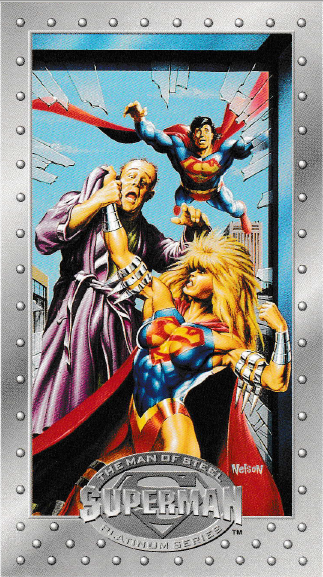 |
| #82: "The Vengeance of Supergirl!" — painted by Nelson DeCastro |
In summary, this trading card set was a card set done right — it was released at the right time (i.e., just as the non-sports trading card boom was picking up steam), featured the right talent and focused on something fans were excited for. Utilizing over-sized/widevision trading cards to give us
more art was a brilliant use of the card, considering the talent working on these cards. Releasing these at two price points also made it accessible to both casual and die-hard trading card collectors. Prices on these trading card sets vary wildly (depending on the dealer), but a full base set of
premium edition will almost always cost at least three times as much as the budget-friendly
collector's edition. I found the base set cards nice enough on their own, and decided to skip out on collecting the
SpectraEtch insert cards. If you ever do happen to chance upon a
SkyDisc for a decent price (and you decide to buy it), send me a photo so I can envy you from a distance.
In the longview, I
don't know if these cards succeeded in raising interest/readership for the Superman books being published by
DC at the time. I
do remember being very interested in Superman's history for a while after collecting these, but I also remember the landscape of the
DCU had changed dramatically by this point and I suddenly didn't recognize many of the current characters running around anymore — so I'd mainly stick to collecting back issues from the late 80s. As far as raising awareness in
John Byrne's post-
Crisis work on Superman, this trading card set was successful.
-Justin
